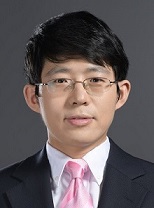
Xiaoyan Li is an associate professor in the Department of Engineering Mechanics. His current research interests focus on deformation and fracture mechanisms/behaviors of nanostructured materials (including nanocrystalline and nanotwinned materials, low-dimensional materials), energy storage materials, biological materials and mechanical metamaterials.
Address: Room N527, Mengminwei Science Building, Tsinghua University, Beijing, 100084 China
Tel: +86-10-62789491(office); Email:xiaoyanlithu@tsinghua.edu.cn
Education background
09/2007 - 01/2012 Ph. D in Solid Mechanics (05/2012)
M. S. in Applied Mathematics (05/2010)
Brown University, USA
09/2003 - 07/2007 Ph. D in Engineering Mechanics (07/2007)
M. S. in Engineering Mechanics (07/2007)
Tsinghua University, China
09/1999 - 07/2003 B. S. in Engineering Mechanics (07/2003)
B. S. in Information & Computing Science (07/2003)
Xi’an Jiaotong University, China
Experience
09/2012 - Present Associate Professor
Department of Engineering Mechanics
Tsinghua University, China
02/2012 - 06/2012 Postdoctoral Associate
School of Engineering
Brown University, USA
Social service
Member, American Society of Mechanical Engineers
Member, American Chemical Society
Member, American Physical Society
Member, Materials Research Society
Member, Chinese Society of Theoretical and Applied Mechanics
Editorial board member of SCIENTIA SINICA Technologica (in Chinese and English) (2018-2022)
National and International Committee Members for 14th International Conference on Nanostructured Materials in 2018
Board member for Micro-/Nano-mechanics Bureau in Chinese Society of Theoretical and Applied Mechanics
Delegate of labor union convention at Tsinghua in 2015-2020
Review serving for more than 30 academic journals, including Nature Communications, Nano Letters, Proceedings of the National Academy of Sciences USA, Journal of Mechanics and Physics of Solids, Journal of Applied Mechanics, Acta Materialia, Scripta Materialia, Modelling and Simulation in Materials Science and Engineering, ACS Applied Materials & Interfaces, Advanced Engineering Materials, Composite Science and Technology, Extremely Mechanics Letters, Philosophical Magazine Letters, Physical Chemistry Chemical Physics, National Science Review, Nanoscale, Scientific Reports, Computational Materials Science, Proceedings of the Royal Society of London A, Archive of Applied Mechanics, International Journal of Mechanical Sciences, Acta Meachnica Sinica, Acta Meachnica Solid Sinica, Acta Physica Sinica, Science China Physics, Mechanics & Astronomy, etc.
Honors And Awards
2017 Wang Ren Award for Young Faulty
Plasticity Bureau in Chinese Society of Theoretical and Applied Mechanics
2017 First Rank Award for Teaching Competition over all Colleges and Universities at Beijing
Beijing General Labor Union
2016 Distinguished Young Researcher (“Xue Shu Xin Ren” Award) at Tsinghua
Tsinghua University
2016 First Rank Award for Teaching Competition at Tsinghua
Tsinghua University
2016 Outstanding Reviewer Awards
Modelling and Simulation in Materials Science and Engineering (an IOP Publishing Journal)
2015 National Science Fund for Excellent Youth Scientists
National Natural Science Foundation of China
2013 Organization Department of the Communist Party of China
2012 Best Paper Award for ICF 2013 as a Young Scientist
13th International Congress on Fracture
2011 2011 MRS Fall Meeting Graduate Student Silver Award
Material Research Society
2010 The William H. Findley Award for Best Graduate Student Paper
Brown University
2008 The James Rice Fellowship
Brown University
Academic Achievement
So far,Xiaoyan Lihas published 43 papers (26 after joining Tsinghua) in refereed journals, including Nature, Nature Materials, Nature Nanotechnology, Nature Communications, Nano Letters, Proceedings of the National Academy of Sciences USA, Advanced Materials, Physical Review Letters, Nano Energy, Science Advances, Small etc., as well as important journals in the field of mechanics (including Journal of Mechanics and Physics of Solids, Journal of Applied Mechanics, International Journal of Solids and Structures); and 1 book chapter. The work has been reported and highlighted by public media and agents, such as NSF, R&D Mag, ScienceDaily, PhysOrg, Nanotimes, Nanowerk and Sciencenet.cn. A few representative papers are given as follows (more details can be found through http://www.researcherid.com/rid/B-7325-2008).
Xiaoyan Li, Yujie Wei*, Lei Lu, Ke Lu, and Huajian Gao*. Dislocation nucleation governed softening and maximum strength in nano-twinned metals. Nature, 464, 877-880 (2010).
Xiaoyan Li* and Huajian Gao*. Mechanical metamaterials: Smaller and stronger. Nature Materials, 15, 373-374 (2016).
Dongchan Jang*,Xiaoyan Li, Huajian Gao*, and Julia R. Greer. Deformation mechanisms in nanotwinned metal nanopillars. Nature Nanotechnology, 7, 594-601 (2012). (Dongchan Jiang andXiaoyan Liequally contributed to this work.)
Yoon Ah Shin, Sheng Yin,Xiaoyan Li*, Subin Lee, Sungmin Moon, Jiwon Jeong, Minhyug Kwon, Seung Jo Yoo, Young-Min Kim, Teng Zhang, Huajian Gao*, and Sang Ho Oh*. Nanotwin governed toughening mechanism in hierarchically structured biological materials. Nature Communications, 7, 10772 (2016).
Jialiang Lang, Bin Ding#, Ting Zhu, Hanxiao Su, Hao Luo, Longhao Qi, Kai Liu, Ke Wang, Naveed Hussain, Chunsong Zhao,Xiaoyan Li*, Huajian Gao, and Hui Wu*. Cycling of a lithium-ion battery with a silicon anode drives large Mechanical actuation. Advanced Materials, 28, 10236-10243 (2016).
Haolun Wang, Xuan Zhang#, Ning Wang*, Yan Li, Xue Feng, Ya Huang, Chunsong Zhao, Zhenglian Liu, Minghao Fang, Gang Ou, Huajian Gao*,Xiaoyan Li*, and Hui Wu*. Ultralight, scalable, and high-temperature–resilient ceramic nanofiber sponges. Science Advances, 3, e1603170 (2017).
Bin Ding#,Xiaoyan Li*, Xuan Zhang#, Hui Wu, Zhiping Xu, and Huajian Gao*. Brittle versus ductile fracture mechanism transition in amorphous lithiated silicon: From intrinsic nanoscale cavitation to shear banding. Nano Energy, 18, 89-96 (2015).
Xiaoyan Li*, Ming Dao, Christoph Eberl, Andrea Maria Hodge, and Huajian Gao*. Fracture, fatigue, and creep of nanotwinned metals. MRS Bulletin, 41, 298-304, (2016).
Xiaoyan Li, Sheng Yin, Sang Ho Oh, and Huajian Gao*. Hardening and toughening mechanisms in nanotwinned ceramics. Scripta Materialia, 133, 105-112, (2017).
Teng Zhang,Xiaoyan Li, and Huajian Gao*. Defects controlled wrinkling and topological design in graphene. Journal of the Mechanics and Physics of Solids, 67, 2-13 (2014). (Teng Zhang andXiaoyan Liequally contributed to this work.)
Teng Zhang,Xiaoyan Li, and Huajian Gao*. Fracture of graphene: a review. International Journal of Fracture, 196, 1-31, (2015).
Xiaoyan Li, Yujie Wei, Wei Yang, and Huajian Gao*. Competing grain-boundary and dislocation mediated mechanicsm in plastic strain recovery in nanocrystalline Aluminum. Proceedings of the National Academy of Sciences of the United States of America, 106, 16108-16113 (2009).
Xiaoyan Li, Wei Yang*, and Bin Liu. Bending induced rippling and twisting of multiwalled carbon nanotubes. Physical Review Letters, 98, 205502 (2007).
Xiaoyan Li*, Zikun Wang*, and Shangheng Huang. Love waves in functionally graded piezoelectric materials. International Journal of Solids and Structures, 41, 7309-7328 (2004).

